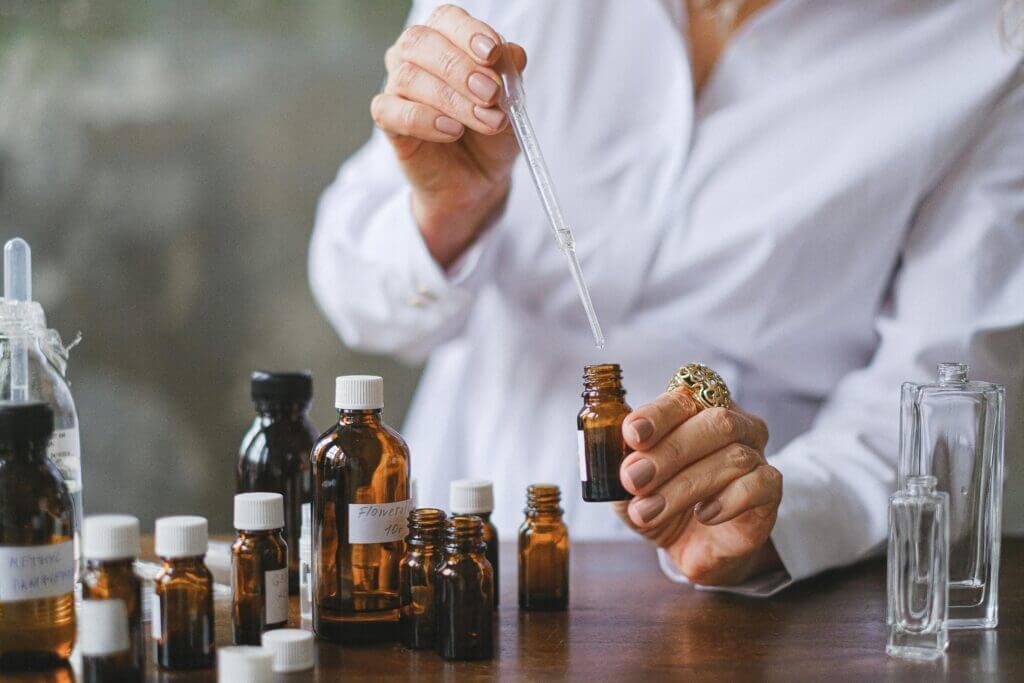Soap making is both art and science. It’s fun to create unique scents. Essential oils add natural fragrance and health benefits. However, blending them requires care to get the right scent.
We’ll show you how to blend essential oils for scented soaps.
Understanding Essential Oil Notes
Knowing fragrance notes is key when blending oils. Essential oils are divided into top, middle, and base notes, like perfume.
- Top Notes – These oils smell first and go away fast.
- Examples: Lemon, Bergamot, Peppermint, Eucalyptus
- Characteristics: Fresh, citrusy, herbal, uplifting
- Middle Notes – These oils give the scent body and balance.
- Examples: Lavender, Rosemary, Chamomile, Geranium
- Characteristics: Floral, spicy, herbal, balanced
- Base Notes – These oils last the longest and add depth.
- Examples: Patchouli, Sandalwood, Cedarwood, Vanilla
- Characteristics: Earthy, woody, musky, warm
A good blend has oils from each category for a lasting scent.
Essential Oil Blending Ratios
Start with this ratio for a balanced blend:
- 30% Top Notes
- 50% Middle Notes
- 20% Base Notes
For example, with 10 drops, use:
- 3 drops of Lemon (Top Note)
- 5 drops of Lavender (Middle Note)
- 2 drops of Cedarwood (Base Note)
Changing these ratios can change the scent’s strength and how long it lasts.
Popular Essential Oil Blends for Soap Making
Not sure where to start? Here are some great blends:
1. Relaxing Blend
- 5 drops Lavender (Middle)
- 3 drops Chamomile (Middle)
- 2 drops Sandalwood (Base)
Best For: Soaps for calming and soothing, perfect for bedtime.
2. Refreshing Citrus Blend
- 4 drops Sweet Orange (Top)
- 4 drops Lemon (Top)
- 2 drops Cedarwood (Base)
Best For: Morning showers to wake you up, lifts your mood.
3. Earthy & Woody Blend
- 3 drops Patchouli (Base)
- 4 drops Rosemary (Middle)
- 3 drops Eucalyptus (Top)
Best For: Grounding and balancing, great for men’s soaps.
4. Floral Bliss Blend
- 5 drops Geranium (Middle)
- 3 drops Ylang Ylang (Middle)
- 2 drops Vanilla (Base)
Best For: Romantic, feminine, and luxurious soaps.
5. Spicy & Warm Blend
- 3 drops Clove (Middle)
- 3 drops Cinnamon (Middle)
- 4 drops Sweet Orange (Top)
Best For: Cozy, autumnal, or winter-themed soaps.
Testing & Adjusting Your Blend
Before adding your essential oil blend to soap, it’s essential to test it:
- Blotter Test: Apply a few drops to a cotton pad or fragrance strip and let it sit for an hour. Smell it at different intervals to see how the scent develops.
- Dilution Test: Mix your blend with a carrier oil (like jojoba or sweet almond oil) and apply to your skin. This helps identify any irritation risks.
- Soap Test: Before making a full batch, test your blend in a small portion of soap.
How to Add Essential Oils to Soap
Essential oils should be added at trace (when the soap thickens but is slightly pourable) in cold process soap making. Use 0.5 to 1 ounce per pound of soap base for a noticeable but safe scent.
For melt-and-pour soap, add essential oils after the soap is melted and slightly cooled. This avoids evaporation.

Tips for Long-Lasting Scents in Soap
- Use Stronger Base Notes – Base notes evaporate slower, making scents last longer.
- Blend With Fixatives – Oils like benzoin, patchouli, and frankincense extend fragrance longevity.
- Avoid Overheating – High temperatures cause essential oils to dissipate quickly. Add oils at lower temperatures in melt-and-pour or after trace in cold process soap.
- Cure Your Soap Properly – Let cold process soaps cure for at least 4–6 weeks in a cool, dark place to retain their scent.
- Store Your Soap Correctly – Keep finished soaps in an airtight container or wrap them in wax paper to maintain fragrance over time.
Essential Oil Safety in Soap Making
- Dilution Matters – Essential oils are highly concentrated, so avoid using them undiluted on the skin.
- Avoid Phototoxic Oils – Citrus oils like lemon, lime, and bergamot can increase skin sensitivity to sunlight.
- Check for Allergens – Some oils, like cinnamon and clove, can be irritating and should be used in lower amounts.
- Pregnancy and Children – Some essential oils are not safe for pregnant women or young children, so always research before use.
- Check Expiration Dates – Essential oils degrade over time, so always use fresh, high-quality oils.
Advanced Blending Techniques
- Layering Scents: Try blending oils with complementary undertones, like floral and citrus, or woody and spicy notes.
- Seasonal Blends: Adjust your blends based on the time of year—light and refreshing for summer, warm and cozy for winter.
- Custom Signature Blends: Experiment with three or more oils to create a unique scent that represents your brand or personal preference.
- Synergy Blends: Some oils enhance each other’s properties. For example, combining lavender and peppermint creates a refreshing yet relaxing effect.
- Using Resin and Floral Infusions: Consider using resins like frankincense or floral-infused oils to deepen and enrich your blends.
- Blending Based on Skin Benefits: For example, tea trees and eucalyptus are great for acne-prone skin, while chamomile and sandalwood are excellent for dry or sensitive skin.
Experimenting With Custom Blends
Blending essential oils is fun. Start with simple blends and then try more complex ones. Keep a journal to see what works best.
Here’s a simple 3-step method to create a custom blend:
- Pick a Theme: Choose if you want a calming, energizing, floral, or earthy scent.
- Choose Oils From Each Category: Pick one top, one middle, and one base note oil.
- Test & Adjust: Blend in small amounts and adjust until it smells just right.
Final Thoughts
Blending essential oils for soap making is fun and rewarding. You can make soaps that smell great and are good for your skin. You can make soaps with floral, citrus, earthy, or spicy scents.
Start with classic blends and then make your own. Your handmade soaps will smell amazing and be unique!

Frequently Asked Questions (FAQs)
1. What are the best essential oils for long-lasting soap fragrance?
Base note oils like patchouli, sandalwood, and cedarwood have long-lasting scents that help anchor other oils in the blend.
2. How much essential oil should I add to soap?
The recommended usage rate is 0.5 to 1 ounce per pound of soap base to ensure a noticeable but safe scent.
3. Can I mix different essential oils?
Yes! Combining top, middle, and base notes creates a well-rounded scent. Experimenting with different ratios will help you find the perfect blend.
4. How do I make my soap smell stronger?
Using stronger base note oils, adding a fixative like frankincense, and curing your soap properly for 4–6 weeks will enhance the scent.
5. Why does my soap lose its scent over time?
Essential oils can evaporate if the soap is exposed to air. Store soaps in an airtight container or wrap them in wax paper to preserve their fragrance.
6. Are essential oils safe for all skin types?
Not all essential oils are suitable for sensitive skin. Always conduct a patch test and avoid known irritants like cinnamon, clove, or certain citrus oils if you have sensitive skin.
7. Can I use fragrance oils instead of essential oils?
Fragrance oils are synthetic and may not have the same therapeutic benefits as essential oils, but they can provide a longer-lasting scent in soap.
8. What’s the best way to blend essential oils for seasonal soaps?
For summer, try citrus and floral blends like lemon and lavender. For winter, opt for warm, spicy notes like cinnamon and clove combined with vanilla.
